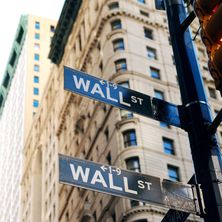

The term Wall Street is synonymous with the epicenter, literal and figurative, of the US financial sector, even though the street is no more than a kilometer long and the headquarters of most of New York's, and obviously America's, biggest firms are not actually located on it. However, the street is home to the New York Stock Exchange, which is the world's largest stock exchange in terms of average daily trading volume and total market capitalization of its listed companies, thus making Wall Street the heart of not only American, but also global, finance.
There are several theories about the provenance of the original Dutch name of the street, de Waal Straat. Some say that the early settlers of New Amsterdam had built a fortification in the form of a palisade that ran from the eastern shore of Manhattan to the western shore. It was used to protect the settlement against the Indians and in Dutch would have been called Wal. Others say, however, that since the early English maps show Waal Straat, with two a's, the origins of the name came from the name Waal, which in Dutch meant Walloon. Wallonia is the current French-speaking southern part of Belgium. There were many Walloon families that had settled the area with the Dutch in the beginning of the 17th century.
Whatever the origin of the name is, we know for a fact that in 1711, when New York was already a British possession, the city government made Wall Street New York's first official market for the sale and rental of African or Indian slaves. By the end of the 18th century Wall Street was the spot where traders would gather to trade securities. They would do it under a buttonwood tree, which in 1792 gave its name to the Buttonwood Agreement, the document that founded the New York Stock & Exchange Board. The board became known as the New York Stock Exchange.
Wall Street was also the place of America's first presidential inauguration. George Washington was sworn in as president in Federal Hall, in front of a cheering public that stretched all the way out to the shore. Fifty years later Wall Street was already the banking capital of America. The area was occupied mostly by businesses with residents having moved uptown. The construction of the Erie Canal, which ran east-west through New York State, connecting New York City to the Great Lakes on the border of Canada, gave an additional boost to ambitious Manhattan businessmen. By the end of the 19th century all the major American corporations, such as Rockefeller's Standard Oil and J.P. Morgan & Company, had their headquarters on Wall Street. In 1889 the local stock report got a new name, the Wall Street Journal, soon becoming the most influential financial newspaper in the world. At the turn of the century the New York Stock Exchange's only global competitor was the London Stock Exchange, but after World War First the scales were tipped in New York's favor.
Wall Street's darkest day was October 24, 1929, known as Black Tuesday, when the stock market crashed leaving a fourth of America's population without work for the next decade. The Great Depression affected most economies in the western countries and it was only after World War Second that America's, and consequently the West's, economy began to flourish again. In the second half of the 20th century Wall Street had other slumping periods, but they were never as gloomy as the 1929 crash. Although nearly all the big corporations no longer have their headquarters on Wall Street (the American branch of the German Deutsche Bank is perhaps the only exclusion), the street and the area around it are still home to many office buildings, and even if one day the street ceases to be the world's financial capital, it will always represent America's sky-high entrepreneurial spirit.